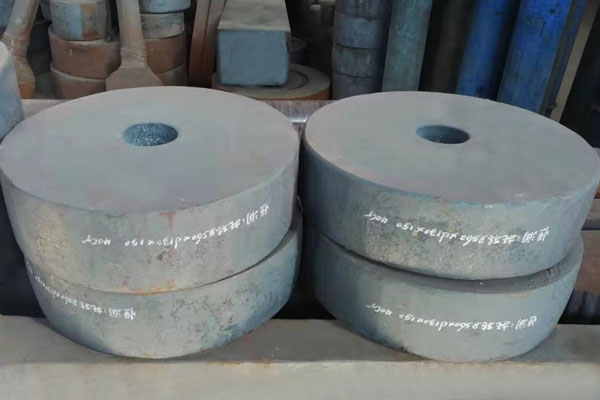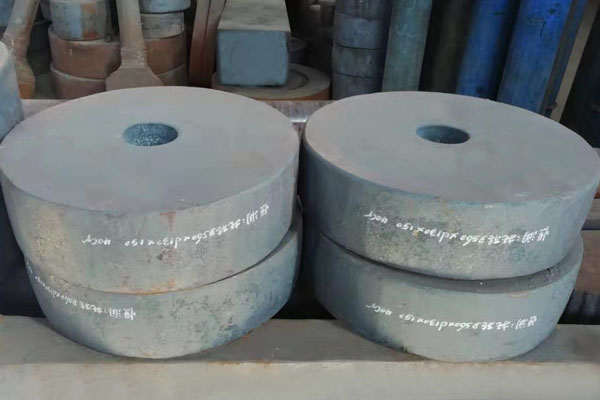

铸造裂纹
(1)钢锭缺点惹起的铸造裂纹 大片面钢锭缺点,铸造时都大概造成开裂,图片6-8所示为2Cr13主轴锻件中间裂纹。这是因为该6t钢锭凝集时结晶温度局限窄,线压缩系数大。冷凝补缩不足,表里温差大,轴心拉应力大,沿枝晶开裂,造成钢锭轴心晶间裂纹,该裂纹在铸造时进一步扩大而成主轴锻件中已裂纹。
该缺点可经历下列措施予以消除:①进步冶炼钢水纯洁度;②铸锭迟钝冷却,削减热应力;③接纳优越的发烧剂与保温帽,增大补缩才气;④接纳中间压实铸造工艺。
(2)钢中有害杂质沿晶界析出惹起的铸造裂纹 钢中的硫常以FeS形式沿晶界析出,其熔点仅有982℃,在1200℃铸造温度下,晶界上FeS将发生融化,并以液态薄膜形式困绕晶粒,破坏晶粒间的结合而产生热脆,轻微锻击就会开裂。
钢中含铜在1100~1200℃温度下的过氧化性气氛中加热时,由于选定性氧化,上层会造成富铜区,当跨越铜在奥氏体中溶解度时,铜则以液态薄膜形式漫衍于晶界,造成铜脆,不行铸造成形。要是钢中还存在有锡、锑还会紧张低落铜在奥氏体中的溶解度,加剧这种脆化倾向。
(3)异相(第二相)惹起的铸造裂纹 钢中第二相的力学性能往往和金属基体有很大的差别,于是在变形流动时会惹起附加应力导致整体工艺塑性下降,一旦部分应力跨越异相与基体间结合力时,则发生分别辨别造成孔洞。例如钢中的氧化物、氮化物、碳化物、硼化物、硫化物、硅酸盐等等。假设这些相呈密集。链状漫衍,尤其在沿晶界结合力微弱处存在,高温锻压就会开裂。图片6-10是20SiMn钢 87t锭因微细的 AlN沿晶界析出惹起铸造开裂的宏观形貌,其表面曾经氧化,出现多面体柱状晶。微观说明评释,铸造开裂与微细的颗粒状AlN沿一次晶晶界大量析出有关。
对策是:
1)限制钢中加铝量,去除钢中氮气或用加钛法抑制AlN析出量;
2)接纳热送钢锭,过冷相变处理工艺;
3)进步热送温度(>900℃)干脆加热铸造;
4)锻进步行充分的匀称化退火,使晶界析出相分散。
6.过热、过烧与温度不均
加热温度过高或高温停顿光阴过长时易惹起过热、过烧。过热使质料的塑性与打击韧性显著低落。过烧时质料的晶界剧烈氧化大概融化,完全落空变形才气。
当加热温度漫衍紧张不匀称,阐扬为锻坯表里、正背面、沿长度温差过大,在铸造时惹起不均变形,偏心铸造等缺点,亦称欠热。
对策是:
l)严酷实行正确的加热规范;
2)留意装炉方法,防止部分加热;
3)调准测温仪表,经心加热操纵,控制炉温、炉气流动,防止不匀称加热。
自由锻件厂商哪家好,就找唐山盛通锻造有限公司。
Casting crack
(1) Casting cracks caused by the defects of steel ingots The disadvantages of large-section steel ingots are probably caused by cracking during casting. Figures 6-8 show the intermediate cracks of 2Cr13 spindle forgings. This is because the crystallization temperature is narrow and the line compression coefficient is large when the 6t steel ingot is agglomerated. Insufficient condensation and shrinkage, large temperature difference in the surface, large axial tensile stress, cracking along the dendrites, causing intergranular cracks in the ingot axis, which is further enlarged during casting to become cracked in the spindle forging.
This shortcoming can be eliminated by the following measures: 1 improving the purity of molten steel; 2 ingot cooling, reducing thermal stress; 3 receiving superior heat-generating agent and thermal insulation cap, increasing the feeding capacity; 4 receiving the intermediate compact casting process.
(2) The sulfur in the cast cracked steel caused by the precipitation of harmful impurities along the grain boundary in steel often precipitates along the grain boundary in the form of FeS. Its melting point is only 982 °C. At the casting temperature of 1200 °C, FeS will melt on the grain boundary. And the film is trapped in the form of a liquid film, destroying the bond between the grains to produce hot brittleness, and slight forging will crack.
When the copper in the steel is heated in a peroxidizing atmosphere at a temperature of 1100 to 1200 ° C, the upper layer causes a copper-rich region due to selective oxidation. When the solubility in copper is in the austenite, the copper is in the form of a liquid film. It is distributed in the grain boundary, causing copper to be brittle and not casting. If there are tin and antimony in the steel, the solubility of copper in the austenite will be weakened, which will aggravate this embrittlement tendency.
(3) The mechanical properties of the second phase in the cast cracked steel caused by the heterogeneous (second phase) tend to be very different from that of the metal matrix, so that additional stress will be caused during the deformation flow, resulting in a decrease in the overall process plasticity. When the bonding force between the heterogeneous phase and the substrate is crossed, the holes are separately identified. For example, oxides, nitrides, carbides, borides, sulfides, silicates, and the like in steel. Assume that these phases are dense. Chain-like diffusion, especially in the weak adhesion along the grain boundary, high temperature forging will crack. Figure 6-10 shows the macroscopic morphology of the 87t ingot of the 20SiMn steel due to the precipitation of fine AlN along the grain boundary. The surface is once oxidized and polyhedral columnar crystals appear. According to the microscopic explanation, the casting cracking is related to the precipitation of fine granular AlN along the primary crystal grain boundary.
The countermeasures are:
1) limiting the amount of aluminum added to the steel, removing nitrogen from the steel or suppressing the precipitation of AlN by adding titanium;
2) Accepting hot-sending steel ingots, supercooled phase change treatment process;
3) Progressive hot delivery temperature (>900 ° C) simply heating casting;
4) Forging into the foot and fully aligning the annealing to disperse the grain boundary precipitation phase.
6. Overheating, overheating and uneven temperature
If the heating temperature is too high or the high temperature is too long, it will easily cause overheating and overheating. Overheating significantly reduces the plasticity and impact toughness of the material. During the over-burning, the grain boundary of the material is violently oxidized and melted, and it is completely emptied and deformed.
When the heating temperature is uneven, it is said that the forging billet is in the front, the back, the temperature difference is too large, causing uneven deformation during casting, eccentric casting and other shortcomings, also known as underheating.
The countermeasures are:
l) Strictly implement the correct heating specifications;
2) Pay attention to the furnace charging method to prevent partial heating;
3) Adjust the temperature measuring instrument, control the temperature of the furnace and the flow of the furnace gas to prevent uneven heating.
